The science behind why we do certain things is referred to as behavioral science. This science applies directly to the core of branding, marketing, and shopping. It not only hypothesizes, but also proves, that human behavior is what truly drives customer purchases.
Behavioral science directly applies to branding because it influences behavior. It’s been proven that your brand has a significant impact on consumer behavior because it shapes their perception of your business. This perception alters the way your audience interacts with your offerings simply because it changes how they view you.
Brand is inherently linked to behavior since it represents the perception of your business. The science supporting investment in branding, marketing, and advertising is the same science that explores human behavior. The purpose of any marketing or advertising is to influence behavior. Similarly, brand strategy and design are built on psychological principles that influence preference, perceived value, and the prominence of your business.
Behavioral science examines human actions and decisions, revealing that humans are often irrational in their behavior. From financial spending and purchases to social media posts and daily habits, humans don’t always behave in the rational ways we might expect. This science has debunked many economic beliefs, as many economic models are based on the assumption of rational human behavior. These models fail to predict certain behaviors, such as the panic buying of toilet paper in 2020 or fluctuations in the stock market, which are driven by irrationality and emotion.
Since most behavior is irrational and driven by emotions, this is precisely what makes brands so powerful. The science of emotion and behavior favors brands because they connect with consumers on an emotional level. While businesses focus on rationality and logic, brands tap into the emotional aspect of the consumer.

This is achieved by developing an effective brand through empathy and understanding of the ideal buyer. Their concerns, aspirations, ideals, beliefs, and even pains are all taken into account. How they feel when shopping for your offering or making a purchase—whether it’s an enjoyable experience like planning a vacation or a stressful one like repairing a car—shapes their perception of your business, which in turn forms your brand. This directly influences their behavior toward your business.
The emotional approach to branding works in several ways:
Relevance
By listening to your audience and being empathetic, you can realign your brand and marketing efforts to better resonate with them. This makes your brand more relevant to your ideal buyer and makes your business their preferred option because you “get them.”
Recall
We tend to better remember events and information when emotions are involved. Just as a tragic event may linger in our minds, emotional connections with brands enhance recall. When your brand aligns with these emotions, you’ll be more salient and have a higher likelihood of being remembered when the decision-making time arrives for your buyer.
Rarity
Just as we value friendships that resonate with us, we appreciate brands that connect with our emotions. The uniqueness of this connection is derived from the distinct nature of the brand, making it appealing to specific consumers. This is why some people prefer Nike while others prefer Adidas—the uniqueness of each brand appeals to different audience members.
Emotions forge connections and drive relationships, altering our mental and physical states. For example, a brand’s marketing that makes you laugh successfully impacts your current state to be happy. This emotional association creates a positive perception of the brand in your mind, highlighting the powerful influence of emotions.
Human behavior can be swayed by emotional elements that directly affect our psychological and physical states. The best way to evoke and influence these emotions is through the power of branding, utilizing relevance, recall, and rarity.

